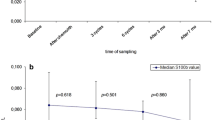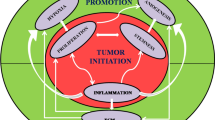Abstract
Our aim was to study the association of two potential serum biomarkers glial fibrillary acidic protein (GFAP) and epidermal growth factor receptor (EGFR) with prognostic markers such as IDH1 mutation, tumor burden, and survival in patients with high-grade gliomas (HGG). Additionally, our objective was to evaluate the potential of serum EGFR as a surrogate marker for EGFR status in the tumor. Pre-operative serum samples were prospectively collected from patients with primary (n = 17) or recurrent (n = 10) HGG. Serum GFAP and EGFR levels were determined by ELISA and studied for correlation with molecular markers including EGFR amplification, tumor volume in contrast-enhanced T1-weighted MRI, and progression-free survival (PFS). Pre-operative serum GFAP level of ≥0.014 ng/ml was 86 % sensitive and 85 % specific for the diagnosis of glioblastoma. High GFAP was related to the lack of IDH1 mutation (P = 0.016), high Ki67 proliferation index (P < 0.001), and poor PFS (HR 5.9, CI 1.2–29.9, P = 0.032). Serum GFAP correlated with enhancing tumor volume in primary (r = 0.64 P = 0.005), but also in recurrent HGGs (r = 0.76 P = 0.011). In contrast, serum EGFR levels did not differ between HGG patients and 13 healthy controls, and were not related to EGFR status in the tumor. We conclude that high serum GFAP associates with IDH1 mutation-negative HGG, and poor PFS. Correlation with tumor burden in recurrent HGG implicates the potential of serum GFAP for detection of tumor recurrence. Our results suggest that circulating EGFR is not derived from glioma cells and cannot be used as a marker for EGFR status in the tumor.




Similar content being viewed by others
References
Ohgaki H (2009) Epidemiology of brain tumors. Methods Mol Biol 472:323–342
Gerlinger M, Rowan AJ, Horswell S et al (2012) Intratumor heterogeneity and branched evolution revealed by multiregion sequencing. N Engl J Med 366:883–892
Hygino da Cruz LC, Jr Rodriguez I, Domingues RC, Gasparetto EL, Sorensen AG (2011) Pseudoprogression and pseudoresponse: imaging challenges in the assessment of posttreatment glioma. AJNR Am J Neuroradiol 32:1978–1985
Holdhoff M, Yovino SG, Boadu O, Grossman SA (2013) Blood-based biomarkers for malignant gliomas. J Neurooncol 113:345–352
Eng LF, Ghirnikar RS, Lee YL (2000) Glial fibrillary acidic protein: GFAP-thirty-one years (1969–2000). Neurochem Res 25:1439–1451
Herrmann M, Vos P, Wunderlich MT, de Bruijn CH, Lamers KJ (2000) Release of glial tissue-specific proteins after acute stroke: a comparative analysis of serum concentrations of protein S-100B and glial fibrillary acidic protein. Stroke 31:2670–2677
Vos PE, Jacobs B, Andriessen TM, Lamers KJ, Borm GF, Beems T, Edwards M, Rosmalen CF, Vissers JL (2010) GFAP and S100B are biomarkers of traumatic brain injury: an observational cohort study. Neurology 75:1786–1793
Jung CS, Foerch C, Schanzer A, Heck A, Plate KH, Seifert V, Steinmetz H, Raabe A, Sitzer M (2007) Serum GFAP is a diagnostic marker for glioblastoma multiforme. Brain 130:3336–3341
Husain H, Savage W, Grossman SA et al (2012) Pre- and post-operative plasma glial fibrillary acidic protein levels in patients with newly diagnosed gliomas. J Neurooncol 109:123–127
Brommeland T, Rosengren L, Fridlund S, Hennig R, Isaksen V (2007) Serum levels of glial fibrillary acidic protein correlate to tumour volume of high-grade gliomas. Acta Neurol Scand 116:380–384
Ohgaki H, Kleihues P (2007) Genetic pathways to primary and secondary glioblastoma. Am J Pathol 170:1445–1453
Hegi ME, Rajakannu P, Weller M (2012) Epidermal growth factor receptor: a re-emerging target in glioblastoma. Curr Opin Neurol 25:774–779
Shinojima N, Tada K, Shiraishi S et al (2003) Prognostic value of epidermal growth factor receptor in patients with glioblastoma multiforme. Cancer Res 63:6962–6970
Oh MJ, Choi JH, Kim IH et al (2000) Detection of epidermal growth factor receptor in the serum of patients with cervical carcinoma. Clin Cancer Res 6:4760–4763
Lafky JM, Wilken JA, Baron AT, Maihle NJ (2008) Clinical implications of the ErbB/epidermal growth factor (EGF) receptor family and its ligands in ovarian cancer. Biochim Biophys Acta 1785:232–265
Gaafar R, Bahnassy A, Abdelsalam I, Kamel MM, Helal A, Abdel-Hamid A, Eldin NA, Mokhtar N (2010) Tissue and serum EGFR as prognostic factors in malignant pleural mesothelioma. Lung Cancer 70:43–50
Asgeirsson KS, Agrawal A, Allen C, Hitch A, Ellis IO, Chapman C, Cheung KL, Robertson JF (2007) Serum epidermal growth factor receptor and HER2 expression in primary and metastatic breast cancer patients. Breast Cancer Res 9:R75
Quaranta M, Divella R, Daniele A, Di Tardo S, Venneri MT, Lolli I, Troccoli G (2007) Epidermal growth factor receptor serum levels and prognostic value in malignant gliomas. Tumori 93:275–280
Capper D, Zentgraf H, Balss J, Hartmann C, von Deimling A (2009) Monoclonal antibody specific for IDH1 R132H mutation. Acta Neuropathol 118:599–601
Ålgars A, Lintunen M, Carpen O, Ristamäki R, Sundström J (2011) EGFR gene copy number assessment from areas with highest EGFR expression predicts response to anti-EGFR therapy in colorectal cancer. Br J Cancer 105:255–262
Tuononen K, Tynninen O, Sarhadi VK et al (2012) The hypermethylation of the O6-methylguanine-DNA methyltransferase gene promoter in gliomas—correlation with array comparative genome hybridization results and IDH1 mutation. Genes Chromosomes Cancer 51:20–29
Ilhan-Mutlu A, Wagner L, Widhalm G et al (2013) Exploratory investigation of eight circulating plasma markers in brain tumor patients. Neurosurg Rev 36:45–56
Horbinski C (2013) What do we know about IDH1/2 mutations so far, and how do we use it? Acta Neuropathol 125:621–636
Choi JH, Oh JY, Ryu SK, Kim SJ, Lee NY, Kim YS, Yi SY, Shim KS, Han WS (1997) Detection of epidermal growth factor receptor in the serum of gastric carcinoma patients. Cancer 79:1879–1883
Acknowledgments
We thank Taina Kirjonen (Department of Physiology, University of Turku), Sinikka Kollanus and Minnamaija Lintunen (Department of Pathology, Turku University Hospital) for excellent technical assistance.
Funding
This study was funded by Cancer Society of Finland and Southwest Finland Hospital District (EVO research funding). A.K. is a Ph.D. student supported by the National Graduate School of Clinical Investigation.
Conflict of interest
The authors declare that they have no conflict of interest.
Compliance with ethical standards
All procedures performed in studies involving human participants were in accordance with the ethical standards of the institutional and/or national research committee and with the 1964 Helsinki declaration and its later amendments or comparable ethical standards.
Informed consent
Informed consent was obtained from all individual participants included in the study.
Author information
Authors and Affiliations
Corresponding author
Rights and permissions
About this article
Cite this article
Kiviniemi, A., Gardberg, M., Frantzén, J. et al. Serum levels of GFAP and EGFR in primary and recurrent high-grade gliomas: correlation to tumor volume, molecular markers, and progression-free survival. J Neurooncol 124, 237–245 (2015). https://doi.org/10.1007/s11060-015-1829-7
Received:
Accepted:
Published:
Issue Date:
DOI: https://doi.org/10.1007/s11060-015-1829-7




